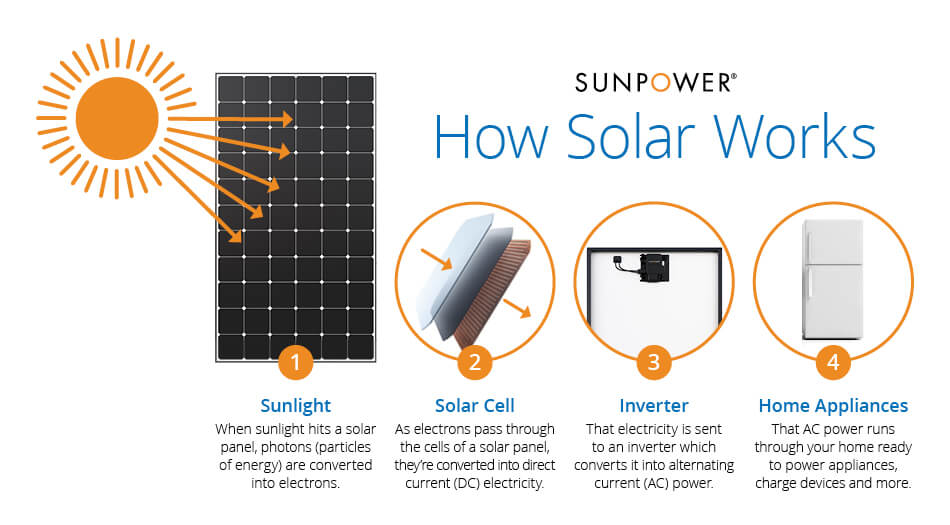Last update May 28th, 2024 at 10:46 am
Not everybody understands how solar panels work. Photovoltaic systems or PV systems can be seen on the rooftop of more than 3 million Australian homes and business buildings. Around 30% of all households in Australia have invested in solar panel technology and may enjoy the benefits of solar energy.
So, how do solar panels work? In this article, we will explain the basics.
The photovoltaic cell
A PV system consists of solar panels and one or more inverters (and sometimes a battery). Solar panels are made of many photovoltaic cells, or solar cells, that are constructed by two slices of so-called semiconducting materials.
In most cases, the photovoltaic cells are consisting of two slices of silicon. Each silicon layer is doped with a material that will cause a negative or positive charge. One layer will be doped with phosphorus, which will give extra electrons and a negative charge.
The other silicone layer in the photovoltaic cell is doped with boron. This results in a lack of electrons and a positive charge. Because of this, an electric field will arise at the junction between the two layers of silicon.

Photons from sunlight hit the PV cell
Sunlight consists of photons, which can be described as small light particles carrying energy. When a photon emitted from the sun hits the photovoltaic cell, an electron will be knocked free from the silicone. This will leave “holes” from escaping electrons.
The electric field will transport the electrons to the negatively charged silicon layer, while wholes are left in the positively charged silicon layer. essentially this is how solar panels work.
If the positive (p-type) layer is connected to the negative (n-type) layer using a metallic wire, electrons are forced to travel from the n-side to the p-side by going through the depletion zone.
The electrons will then travel back to the negative layer through the wire, and create an electric flow.
DC current is converted to AC current
The direct current (DC) generated by the solar panels needs to be converted into usable alternating current (AC) that your home appliances may use. An inverter will transform DC to an alternating 120V/240V current and is an important part of the solar panel system.
Your solar system may have a single-string inverter that will convert DC to AC for all your solar panels. Alternatively, you may install microinverters. This means that each solar panel will have its own inverter.
If your system has a string inverter, all the solar panels will stop working or work less efficiently if just one of the panels is exposed to shade. With the more expensive micro inverters, you can overcome this problem because the solar panels work separately.
What about solar batteries?
We have now explained how solar panels work. However, there are different solar panel systems, and these may work slightly differently from one another. Some solar systems include a battery, while others operate without a battery.
In Australia, most solar systems are without batteries because they are very expensive. However, a battery may be beneficial as it will let you store solar energy and use it for later (for example at night when the solar system does not produce electric energy).
Most solar systems in Australia are grid-tie systems. This means that your home is still connected to the grid. So if your solar system does not produce enough electricity, you are able to use power through the grid.
If your system produces surplus energy, you might sell it through the grid and earn a feed-in tariff.
Do solar panels work when it’s cloudy outside?
Yes. Solar panels normally react to the light spectrum that is visible to the eye. So if there is daylight outside, this will usually be sufficient for your solar panels to produce electricity. That being said, solar panels will produce more efficiently during direct, strong sunlight.
As Australia is known to have a sunny climate, solar technology is very beneficial for most residents and businesses. The sunnier it is; the more electricity will be produced. But remember, extreme heat may affect how the solar panels work.
How to get started with solar panels?
Many Australians would like to install solar panels on their rooftop, as this may give them lower electricity costs and access to feed-in tariffs. At the same time, you will be able to use clean solar energy and reduce your carbon footprint.
Now that you know how solar panels work and if you are considering going solar, you should first find a Clean Energy Council (CEC) accredited installer. The installer will come to your property and help you find the best solution. You will also receive a price quote.
Remember that the solar installation is eligible for a government STC rebate as long as the installer and product are CEC accredited. This means that the Australian government will cover parts of your installation costs.
Find an installer today, and enjoy the benefits of solar energy!